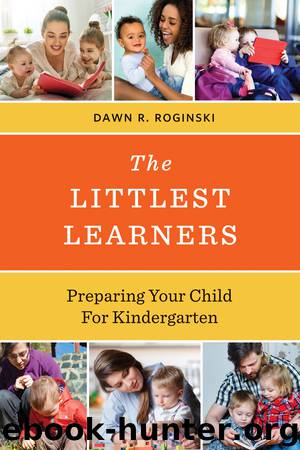The Littlest Learners by Dawn R. Roginski

Author:Dawn R. Roginski
Language: eng
Format: epub
Publisher: Rowman & Littlefield Publishers
Interesting and challenging play materials in a children’s home after the first year predict the child’s later IQ and future school achievement in both reading and math.5 Open-ended toys, as opposed to those with screens, buttons, or plugs, are still best. When purchasing toys for your toddler, choose toys that are versatile and are able to be used in different ways. Typically toddlers love to take things apart and put them back together. They love opening and closing, putting in and taking out. Choose toys that can be used in different ways from one day to the next. For example, plastic nesting cups can be used as pretend dishes, to build a tower or for water play.
Consider looking for toys that will age along with your child. Look for toys that can change their purpose at different development levels. For example, stuffed animals can be used to play house, to create a zoo, or as puppets to retell a story.
Toddlers are rapidly learning language. They eagerly test the limits physically: jumping from heights, climbing, and rough-and-tumble play. Their sense of danger is limited, so adults need to keep a close eye on their explorations. They have good control of their hands and fingers and like to do things with small objects.
Good toys for toddlers include the following:
•items for creating like wide, nontoxic, washable markers or crayons, finger paint, play dough, large paint brushes, colored construction paper, toddler-sized scissors with blunt tips, a chalkboard and large chalk, and rhythm instruments;
•toys for pretending such as toy phones, dolls, baby carriages and strollers, dress-up clothes, puppets or stuffed toys, plastic animals, and vehicles;
•construction supplies such as cardboard and wood blocks; These can now be smaller than the ones used as a baby.
•toys that use their large and small muscles like puzzles, large pegboards, toys with parts that do things (dials, switches, knobs, lids), large and small balls for kicking and throwing, ride-on equipment (but probably not tricycles until children are three), tunnels, and pounding and hammering toys;
•toys that require active handling like nesting toys, stacking toys, and toys for stringing and sorting; All such toys teach about relationships and offer opportunity to talk about concepts like big, bigger, full, empty, and so on. According to the National Association for the Education of Young Children, these concepts as well as those given in figure 3.5 are perfect math concepts to include in our everyday play with toddlers.
•toys that require solving problems like wood puzzles, blocks that snap together, and things with hooks, buttons, buckles, and snaps;
•pretend and building toys such as blocks, smaller transportation toys, construction sets, child-sized furniture (kitchen sets, chairs, play food), dress-up clothes, and sand and water play toys;
•Your “real” stuff, which your toddler also wants to play with(like your cell phone, television remote, garage door opener, and keys); When household items need to be replaced, consider removing batteries and placing in your child’s toy collection.
•“Ready to Read” toys like magnetic alphabet letters and alphabet blocks are now appropriate. Real take-out menus, catalogs, junk mail, or magazines are fun for your child to look at and use in their play.
Download
This site does not store any files on its server. We only index and link to content provided by other sites. Please contact the content providers to delete copyright contents if any and email us, we'll remove relevant links or contents immediately.
The Art of Coaching Workbook by Elena Aguilar(51000)
Trainspotting by Irvine Welsh(21521)
Twilight of the Idols With the Antichrist and Ecce Homo by Friedrich Nietzsche(18509)
Fangirl by Rainbow Rowell(9104)
Periodization Training for Sports by Tudor Bompa(8173)
Change Your Questions, Change Your Life by Marilee Adams(7638)
This Is How You Lose Her by Junot Diaz(6800)
Asking the Right Questions: A Guide to Critical Thinking by M. Neil Browne & Stuart M. Keeley(5652)
Grit by Angela Duckworth(5525)
Red Sparrow by Jason Matthews(5392)
Paper Towns by Green John(5092)
Room 212 by Kate Stewart(5041)
Ken Follett - World without end by Ken Follett(4647)
Housekeeping by Marilynne Robinson(4349)
The Sports Rules Book by Human Kinetics(4299)
Double Down (Diary of a Wimpy Kid Book 11) by Jeff Kinney(4208)
Papillon (English) by Henri Charrière(4199)
The Motorcycle Diaries by Ernesto Che Guevara(4018)
Exercise Technique Manual for Resistance Training by National Strength & Conditioning Association(3960)
